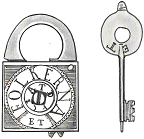 |
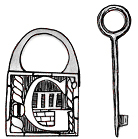 |
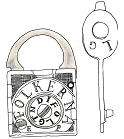 |
 |
| Ornamental locks by Erik Persson, Nordic Museum, Stockholm. Sketches by the author. |
Farmer and smith Erik Persson (Eric Pehrson, Erich Pehrsson), 1707–1794, lived in the village of Bollsjö in the parish of Folkärna (old spelling Folkerna) in Dalarna – close to Avesta and near the border to Västmanland Province to the south. He lived less than 150 kilometers from Stockholm.
Persson was a clever jack of all trades, making padlocks, bells, clocks, boxes, knives, hand axes, and perpetual calendars, while also taking care of his farm.
Samuel Schröder, knighted as Schröderstierna (1720–1779), was the director of finer iron, steel, and metal manufacture in Sweden from 1753 to 1771, and traveled around Sweden inspecting factories such as Christopher Polhem’s in Stjernsund. In his Report on Iron, Steel and Metal Factories of the Years 1755–1759, section 54, written in 1760, he wrote:
“The Farmer Erik Persson in Dalarna and the parish of Folkerna has, alongside his farming tasks, occupied himself with making various kinds of clocks, which are well liked in the area and the larger region. Since then he has also begun to manufacture various other small items of iron, steel, brass, silver and mother-of-pearl, gilded and engraved, such as knives, locks, perpetual calendars and nocturnals, in which art he has also trained his two sons."
“His works of these kinds, of which he was able to show me several examples when he was here in Stockholm in March of 1756, attest that he possesses a skill out of the ordinary, and especially for people of his standing."
“In 1758 he petitioned His Royal Majesty and the Royal Chamber of Commerce for permission for himself and his sons to pursue said handicraft unperturbed in their location under royal manufacturing privileges. I am unaware of any response having been made to said request”.
Pursuing handicrafts and selling the products in one’s local area or in Stockholm without permission was a crime against Swedish guild regulations in those days. The Chamber of Commerce referred the request to the County Governor where Persson lived, who passed it along to Schröderstierna for an opinion. As Schröderstierna said, the Chamber of Commerce never responded in one way or the other, but Erik Persson continued his business without incident until his death in 1794.
As Schröderstierna relates, Erik Persson’s two sons, Anders and Jakob, were trained in their father’s art.
Eight of Erik Persson’s ornamental padlocks are found among the collections of the Nordic Museum and some are described by Brynolf Hellner in the museum’s 1980 yearbook, where he wrote that: “Of Erik Persson’s manufacturing, thus far only four padlocks have been identified, all in the Nordic Museum’s collections.” Today, however, we know that there are more. Eleven years later, in an article in Antik & Auktion magazine, Björn Larsson stated that “there are plenty of padlocks in Pehrsson’s estate, most of them ornamental locks; i.e. a kind of code lock with one or more ingenious devices in addition to the key itself, to prevent unauthorized people from opening the lock.” Which means that, in addition to the Nordic Museum’s eight, there are at least seven more locks, all privately owned. This makes at least fifteen locks in all, two of which is owned by the author.
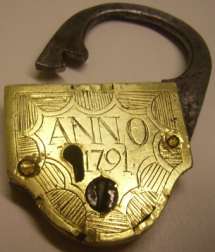 |
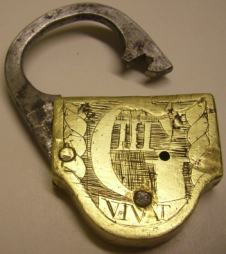 |
| Ornamental lock by Erik Persson in the author’s collection. Photo by the author. |
The lock bodies are always four-sided, with a range of different shapes along the bottom edge. They are made of brass, while the shackles and wards are made of steel. The height varies between 4.5 and 5.7 cm, and the width between 3.0 and 3.8 cm. The thickness varies from 0.8 cm to just under 2 cm. The locks are usually decorated with personal, simple engraving using uneven but bold hatchmarks. The decorated surfaces always feature a single line that follows the outer edge, framing the central design, with a border that may resemble a rope or S curves. One lock has an acanthus-like vine, another geometric patterns. His signature, EP, is found on a few of the locks. One padlock is dated 1791, and the parish name FOLKERNA circumscribed in a circle is featured on a few locks. The word “VIVAT” – his tribute to the King – is engraved in a few places along with the royal cypher of Gustav III and Gustav IIII (IV). Gustav III’s royal cypher is found on most of the locks.
 |
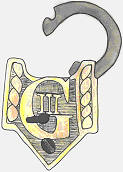 |
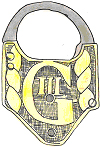 |
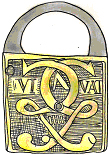 |
| Ornamental locks by Erik Persson, owned privately. Sketches by the author. |
Erik Persson’s padlocks lock automatically when the free leg of the shackle is inserted into the lock body. To open the combination lock, a ward must be passed – a hidden interior flap that opens when the right combination of letters is set on the front of the lock. This is done using the slot in the head of a screw using the tiny screwdriver in the bow of the key, or using the bit of the key.
Literature
Sigurd Erixon. “Ett ålderdomligt låssmide i Dalarna och dess härkomst.” Folk-liv VI. Stockholm, 1942.
Brynolf Hellner. Fataburen, the yearbook of the Nordic Museum and Skansen, 1980.
Olle Homman. “Låssmeder i Lima på 1600–1700-talen.” Folk-liv VI. Stockholm, 1942.
Björn Larsson. Article on village smith Erich Pehrsson in Antik & Auktion issue 11, 1991.
Björn Larsson. “Smed med snille och smak,” answer to a reader’s question on Erich Pehrsson’s padlocks in Antik & Auktion issue 6, 1992.
Samuel Schröderstierna. Berättelser över de finare järn-, stål- och metallfabrikerna i Sverige åren 1754–1759, I, II. Published by Gösta Malmborg. Stockholm 1925.